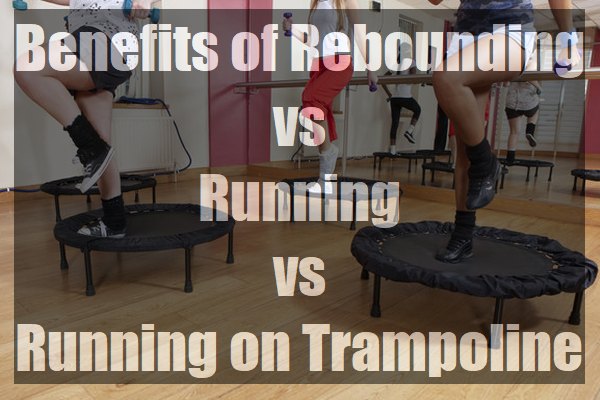
Benefits of Rebounding vs Running vs Running on Trampoline
Which is better? This is an age old debate that always comes up when one individual or group decide their favorite exercise is better than another. Those people who use rebounders over running are no exception.
To find out the winner of this debate or to make up your own mind which is better, continue to read our article. We explore the benefits and more, providing you with the information you need to know to make an intelligent exercise decision.
The Benefits of Rebounding vs Running
You may like running and enjoy the benefits that come from jogging through your neighborhood but are they better than the benefits you get from rebounding? Let’s compare and we will start with those benefits both exercises have in common
Joint benefits
- Burn calories
- Lower blood pressure
- Helps heart rates
- Tones muscles
Running benefits
- Lots of fresh air
- See the sites
- No special equipment needed
Rebounder benefits
- Protect your joints
- Helps your balance
- Improves your coordination
- Can be done privately
Is Rebounding Better Than Running?
The answer is a toss up and depends on the individual. Both provide great exercise and helps you tone your body and reduces your calories. If you suffer from arthritis then rebounding is probably better for you than running.

Also, rebounding helps clean out toxins from your lymph system. Something running does not do. If you like your freedom and lots of fresh air then running is probably better than rebounding.
Our Rebounder Recommendations | Our Rating | Images (click for more) |
|---|---|---|
94 | ||
93 | ||
90 |
Calories Burned Rebounding vs Running
In this case, there can be a clear winner. It is said that if you jog for one mile you burn off 120 calories. If you run 3 miles in 30 minute,you will burn about 360 calories.
A rebounder burns about 420 calories per hour. So in 30 minutes you will only burn only 210 calories. Running is the clear winner.
Is Jumping on a Trampoline as Good as Running?
In terms of exercise and exercise options, jumping on a trampoline is far better than running. You also provide a lot of relief from impacts for your joints when you jump on a trampoline over running on a hard surface.
Also, while running helps your cardiovascular system like a trampoline does, jumping on a trampoline provides you with muscle strengthening options that running cannot compete with.
The only advantage running has over a using a trampoline, is that you do not have to buy expensive special equipment to do it.
Does Running on a Trampoline Work?

The short and simple answer to this question is yes. Any exercise will help you including running on a trampoline. Besides protecting your joints, you can do a variety of running methods and burn as few or as many calories you want.
Running on a trampoline keeps you in control of your running and you can design or pick a running method that is perfect for you. You can run fast, slow, add weights, use resistance bands and more to keep running on a trampoline interesting.
Is Running on a Trampoline Good Exercise
Again, the answer to that question is a strong yes. Not only do you help your cardiovascular system, strengthen your muscles, you also protect your body and keep it healthy.
Also, you do not have to spend a lot of time running on a trampoline to get the exercise you need. All it takes is about 8 to 10 minutes a day and you get the same exercise as if you ran a mile.
The Benefits of Running on a Trampoline
Trampolines are thought to be one of the best exercise options for adults. That is because there are so many ways and methods you can use when you adopt a trampoline as your exercise format.
Here are some of the more important benefits you receive when you use a trampoline:
- Reduce your cellulite issue
- Strengthen your bones
- Increase oxygen circulation
- Improve your immune system
- Detoxify your body
- Improve cardiovascular, coordination, balance and more
Which is Better - Running on a Trampoline vs Treadmill
With a treadmill, your feet are stuck in one position as you run. But with a trampoline you can move your feet as you lift off the mat and do other movements with them before you land and take your next ‘step’.
Walking on a treadmill does not have much impact but if you run then your joints feel the impact a lot more. A trampoline cuts the impact down and your joints hardly feel a thing.
Then a treadmill limits your options You can only go faster or change the incline position. A trampoline you have far more opportunities to alter our movement. Treadmills are great and serve their purpose, but if you have the choice, go with the trampoline as you have more exercise options and more opportunities for fun.
How Many Calories Does Running on a Trampoline Burn?
Of course the amount of calories you burn depends on several factors. How fast you are running, how much you weigh, your gender and what methods you are using. It is possible for a 200 pound man to burn roughly 170 calories in about 30 minutes of running on a trampoline.
You can burn about the same amount of calories running on a trampoline as you do when you run at 6 mph on flat ground.
Some Final Comments
If you are strictly looking at the pros and cons of using a rebounder, or trampoline over running or jogging, then it is safe to say that the rebounder and trampoline are better for you.
Just the impact protection alone makes using those special pieces of equipment worth their expense. Even a treadmill really can’t compare here. But like anything that is compared, it depends on your preferences.
When you look at the overall facts for running on a trampoline, etc., and jogging through the park, you get almost the same calorie burn, the same cardio workout and other similar exercise help.
But what really tips the scale in favor of a rebounder or trampoline is that you can do all your exercises in private. You do not have to leave your home and you do not have to worry about vehicles, cyclists or other people on the street.
Our Rebounder Recommendations | Our Rating | Images (click for more) |
|---|---|---|
94 | ||
93 | ||
90 |




